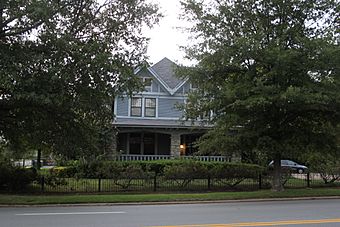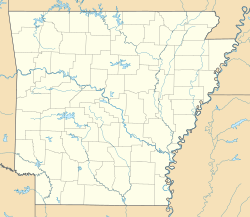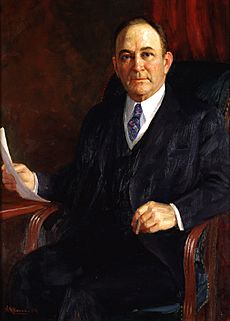Joseph Taylor Robinson House facts for kids
|
Joseph Taylor Robinson House
|
|
|
U.S. Historic district
Contributing property |
|
 |
|
| Location | 2122 Broadway, Little Rock, Arkansas |
|---|---|
| Area | less than one acre |
| Built | 1904 |
| Architect | Frank W. Gibb |
| Architectural style | Stick/Eastlake |
| Part of | Governor's Mansion Historic District (1988 enlargement) (ID88000631) |
| NRHP reference No. | 75000411 |
Quick facts for kids Significant dates |
|
| Added to NRHP | August 28, 1975 |
| Designated NHL | October 12, 1994 |
| Designated CP | May 19, 1988 |
The Joseph Taylor Robinson House is a special old home in Little Rock, Arkansas. It was built in 1904 for a rich lumber businessman. Later, it became the home of Joseph Taylor Robinson, who was a very important politician from Arkansas.
Robinson lived here from 1930 to 1937. During this time, he was a powerful U.S. Senator. He even became the Senate Majority Leader from 1933 to 1937. This means he was the main leader for his political party in the Senate.
He helped pass many important laws called the New Deal. These laws were created by President Franklin D. Roosevelt to help the country during a tough time. President Roosevelt even visited Robinson at this house in 1936! Because of its history, the house was named a National Historic Landmark in 1994.
About the Robinson House
The Robinson house is a large, two-and-a-half-story building. It is made of wood and sits on a strong base of granite and brick. The outside walls are covered with wooden planks called clapboards. The roof is steep and has an interesting, uneven shape.
There are four chimneys on the house. Two are made of brick, and two are a mix of granite and brick. The front of the house faces east. It has a wide porch supported by three square granite posts. Above the porch are two sets of windows.
The top of the house has two pointed sections called gable ends. Each gable has two small square windows. These gables are decorated with stucco and a crisscross wood pattern. The porch has cool, flattened arches and fancy decorations. The main front door is under one of the gables.
The side of the house facing south also has a porch, but it's smaller. Above it is a sleeping porch that is fully enclosed. There's also a window that sticks out from the roof. The back of the house has two small porches. The north side has a window sticking out from the roof, just like the south side.
Inside the house, you'll find lots of beautiful wood. The wood used was very special and unique for its time. For example, the sliding door between the living and dining rooms is made of burled pine. This wood has a swirly, knotty pattern. The tall columns at the entrance to the living room are said to be made from real tree trunks!
Besides the main house, there's also a carriage house on the property. It was built using the same style as the main house. The yard is surrounded by an iron fence on two sides. On the other other sides, it has a rock wall.
History of Joseph Taylor Robinson
The house was designed by an architect named Frank W Gibb. Joseph Taylor Robinson bought the house in 1930. He had been a U.S. Senator since 1913. Robinson lived in this house until he passed away in 1937. His wife continued to live there until her death in 1958.
The house stayed in the Robinson family until 1972. After that, it was used to house people getting cancer treatment in Little Rock. The house was added to the National Register of Historic Places in 1975. It became a National Historic Landmark in 1994. This was because of its strong connection to Robinson during his most important years in national politics. It is one of the best-preserved homes he owned.
Joseph Taylor Robinson was born in 1872 in Lonoke, Arkansas. He went to the University of Arkansas and the University of Virginia Law School. He didn't graduate from either, but he became a lawyer in Arkansas in 1895. He quickly became very good at his job.
In 1902, he was elected to the United States House of Representatives. He served five terms there. Then, he became Governor of Arkansas. He was governor for only 55 days! In early 1913, he was chosen to be a U.S. Senator.
In 1923, Robinson became the Senate Minority Leader. This meant he was the main leader for his party when they were not in control. In 1928, he was chosen to run for Vice President of the United States. He ran with Al Smith, but they lost the election to Herbert Hoover.
When Franklin D. Roosevelt won the election in 1932, his party also gained control of the Senate. This made Robinson the Majority Leader. In this role, he was a key helper for President Roosevelt's New Deal plans. He helped many important laws pass through the Senate. One law that has his name is the Robinson-Patman Act. This law stopped big stores from getting special discounts from manufacturers.
President Roosevelt thought about making Robinson part of his Cabinet. But he decided Robinson was more valuable helping pass laws in the Senate. Robinson only hosted President Roosevelt at his Little Rock home once, on June 10, 1936.




